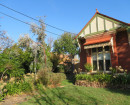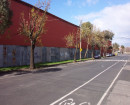FORMER SOUTH YARRA TRAM SUBSTATION
2 DALY STREET SOUTH YARRA, STONNINGTON CITY
-
Add to tour
You must log in to do that.
-
Share
-
Shortlist place
You must log in to do that.
- Download report





Statement of Significance
What is significant?
How is it significant?
Why is it significant?
-
-
FORMER SOUTH YARRA TRAM SUBSTATION - History
CONTEXTUAL HISTORY
The first trams operating in Melbourne were horse-drawn. The first of Melbourne's cable trams opened in 1885 on the Richmond line, and in the following six years the councils of Melbourne and the ten surrounding municipalities built a system of cable-hauled tramways. The 46 miles [74 km] of double track serving seventeen routes radiating from the centre of the city to neighbouring suburbs was probably the world's largest cable tram network, but by 1891 it had reached its maximum extent. By 1900 it was recognised that other countries had established electric tramways that were less expensive to install, and an electric tram had already begun operating in Sydney.
The first electric tram to run in Australia was demonstrated during the Melbourne Centennial International Exhibition in 1888. From 1889 until 1896 this pioneer vehicle and a second car ran a regular tramway service between Box Hill Station and Doncaster, mainly as a means of attracting potential land purchasers, but it did demonstrate the viability of electric traction.
The first two regular electric tram service in Melbourne opened in 1906, with the opening of a line from the cable tram terminus at Flemington Bridge to Essendon and the Victorian Railways line from St Kilda to Brighton. In the early 1900s, several municipalities formed trusts and built electric tramways in their areas. In 1909 Municipal authorities in Prahran and Malvern combined to form a Trust to operate electric tramways within their boundaries and opened lines in 1910, which by 1919 had grown to a network of thirty-five route miles [56 km]. During World War I other suburban electric networks developed, including municipal trust undertakings in the areas of Hawthorn, Brunswick, Coburg, Fitzroy, Kew, Preston and Footscray. Until the State Electricity Commission of Victoria was formed in 1920, electricity for the trams was provided by various private and municipal power generators.
The Victorian Government in 1910 set up a Royal Commission to enquire into the 'present condition of the Railway and Tramway systems of Melbourne'. Their 1911 report recommended electrification of the suburban railway network, and also recommended that all the metropolitan tramways, cable and electric, municipal and private, be vested in a Municipal Tramways Trust, and that the cable tramways be converted to electricity. The advantages of electric tramways were considered to be lower capital costs, greater speed and flexibility, adaptability to extension and simplification of terminal shunting.
Implementation of these recommendations was delayed by World War I, but in 1918 legislation was passed setting up the Melbourne & Metropolitan Tramways Board (M&MTB), which in 1919 took over authority for the cable trams, and in 1920 for the Northcote line and all the electric networks operated by municipal trusts. The M&MTB formulated a comprehensive plan for integration and development of the system as a whole, with considerable extension of the electric lines and gradual conversion of the cable lines.
The first line electrified was the St Kilda line in 1925, and in less than a month electric trams were serving the whole length of Swanston Street. Within the first year a considerable part of the southern section of the system had been electrified. The last cable tram line (Northcote) only closed in 1940. During this time the cable trams were converted to electric traction, new depots and substations were built, lines extended and new routes added. Hundreds of new, large, electric trams were built to replace the fleets of small cars previously operated by the municipal tramway trusts.
Tram Substations
With the establishment of the M&MTB new substations had to be built to electrify the converted cable tram lines and for new routes, and to systematise the distribution of power from the Latrobe Valley generator of the State Electricity Commission (SEC, formed in 1920). Electricity to power Melbourne's tram lines was taken from the state grid system at the substations, where the SEC's alternating current (AC) at 6600 volts was transformed (or rectified) to direct current (DC) at a lower voltage to operate the trams. Substations housed the equipment required to transform the high voltage AC power down to the low voltage DC traction power.
Since the 1880s electric trams have been powered by direct current (DC) at a relatively low voltage - initially at 500 volts, but in later years more commonly between 600 and 700 volts. DC motors were well-suited to use on trams as they were compact and light and could easily be incorporated into the restricted space on the trams. However direct current has a major drawback: voltage drops quickly with distance and tram performance therefore falls off rapidly if the tram is much more than 4 km from the power source. So substations were usually built near the middle of tram routes.
The earliest rectifier systems used mechanical rotary converters with electric motors to drive generators. The initial installations by the tramway trusts were often co-located within the tram depots, such as at Malvern, Kew, Elsternwick, Hawthorn and Coburg depots, which all used massive rotary converters. In the 1930s new technology was introduced, using mercury arc converters, which employed a process involving ionising mercury vapour. These were smaller and were initially housed in glass bulbs and later in steel tanks. From the 1960s the system progressed to solid state silicon diode rectifiers. These are what are now used, together with the extensive use of electronics, to control switching, and require much less space than the old systems. Melbourne had to re-equip its substations in the 1990s due to the higher electric current required to air-condition trams.
In order to reduce supervisory labour costs, the M&MTB constructed remote control equipment of its own design for its substations. The main central control room was in Queensberry Street at Carlton, which was able to operate all the other substations remotely. By 1933 there were 19 substations, 15 of them fully automatic unattended stations, and by 2013 there were 55, with more planned.
Many of the early tram substations were free-standing buildings, the oldest being the Elsternwick substation built by the Prahran & Malvern Tramways Trust in 1914. The early substations housed the massive rotary converters and required deep foundations to prevent damage to the building fabric. They also had large doorways and high roofs, to permit easy handling of the electrical plant, and large high windows to provide natural light. A series of similar large impressive brick substations were built between 1924 and 1929 by the M&MTB in Camberwell, South Yarra, Ascot Vale, South Melbourne and Carlton, all designed to house rotary converters. All were similar in materials and form but varied in their size, floor plans, and the degree of rendering and decoration.
In 2005 a number of Melbourne's substations and their equipment became redundant, including Ascot Vale, Glenhuntly, Essendon, South Yarra, Deepdene, Maribyrnong, Brunswick, West Brunswick, Coburg, Preston and South Melbourne. The old substations were cleared of hazardous materials and new substations were built adjacent to the old buildings.
Alan G Monsborough
Alan G Monsborough was the M&MTB's architect and was responsible for the design of all tramway buildings during the formative years of the electric tramway system. His prodigious output ranged from electric sub-stations and tram depots to the large scale heavy industrial buildings at the Preston tramway workshops, the board's multi-storey head office building in Little Collins Street, Melbourne, the elevated signal cabin and waiting shelter in Swanston Street (1928, VHR H686) and the rustic chalet and passenger shelters at Wattle Park in Burwood (1920s, VHR H904).
HISTORY OF PLACE
The South Yarra substation in Daly Street was the site of a group of tiny houses built in c1885 and owned by a real estate agent called Daly, which acquired the name of Daly Town. The houses were condemned and demolished in 1910.
Daly Street was originally known as Tramway Street, which was a reference to the adjacent Melbourne Tramway & Omnibus Company (MT&OC) cable tram engine house and car shed built in 1887-8. The MT&OC, formed in 1885, ran one of the largest cable tram systems in the world, with about 75 km of double track on 17 routes radiating out from the centre of Melbourne to the surrounding suburbs. In 1916 the company surrendered its authority to the Tramways Board, the forerunner of the M&MTB, which took over the cable tram routes in 1920.
The South Yarra substation was constructed at the rear of the engine house and car shed by the M&MTB in 1927, probably to the design of MMTB's architect Alan G Monsborough. It was one of a number of substations built in the mid-1920s as each section of cable tram route was electrified, including at Carlton, Camberwell and South Melbourne. The South Yarra substation was powered by a 500 KW rotary converter, which by 1942 had been replaced by a mercury arc rectifier.
In 2005 Yarra Trams commissioned a number of new tramway substations and a number of old substations were made redundant, including South Yarra, and their equipment was removed. A new substation was built at the rear of the site. Since 2009 the 1927 building has been occupied by the ladies wear shop Le Louvre, which has involved refitting of the interior.
KEY REFERENCES USED TO PREPARE ASSESSMENT
Biosis Research (Gary Vines), 'Melbourne Metropolitan Tramway Heritage Study', Report for Heritage Victoria, 2011
Information in HV file PL-HE/03/0424 (Maribyrnong Tram Substation)
Public Transport Victoria website: http://corp.ptv.vic.gov.au/managing-victoria-s-public-transport-network/history-and-heritage/early-history-of-public-transport/#trams]
Russell Jones for Friends of the Hawthorn Tram Depot, 'Fares please! An economic history of the Melbourne & Metropolitan Tramways Board', 2008, online at http://www.hawthorntramdepot.org.au/papers/ecohist/ecohist0.htm
John Keating, Mind the Curve! A history of the Cable Trams, Sydney 2001.
Russell Jones for Friends of Hawthorn Tram Depot, 'From Rotary Converters to solid-state: tramway substation architecture in Melbourne', 2013; online at http://www.hawthorntramdepot.org.au/papers/substations.htm.
FORMER SOUTH YARRA TRAM SUBSTATION - Plaque Citation
Built in 1927, this one of five impressive electrical substations built in the 1920s by the Melbourne & Metropolitan Tramways Board as part of the electrification of Melbourne's tram system, and is attributed to the Board's architect Alan Monsborough.
FORMER SOUTH YARRA TRAM SUBSTATION - Assessment Against Criteria
Criterion
The Former South Yarra Tram Substation is of historical and architectural significance to the State of Victoria and satisfies the following criteria for inclusion in the Victorian Heritage Register:
Criterion A Importance to the course, or pattern, of Victoria's cultural history
Criterion D Importance in demonstrating the principal characteristics of a class of cultural places and objects
The Former South Yarra Tram Substation is significant at the State level for the following reasons:
The Former South Yarra Tram Substation is historically significant for its association with the development of Melbourne's transport systems in the early twentieth century, and with the role this played in the development of Melbourne and its suburbs. It is significant for its association with the development by the M&MTB of an integrated electric tramway system from the 1920s and as a demonstration of the scale and quality of works undertaken by the M&MTB. Its location at the rear of the former South Yarra cable tram engine house and car shed (now much altered) reflects the change in technology from cable to electric trams in the 1920s. The former South Yarra substation is one of four 1920s substations which survive relatively intact, and these, individually and as a group, help to demonstrate the scale of the electric tram network developed by the M&MTB in Melbourne and its suburbs and the infrastructure required for this work. (
Criterion A)
The Former South Yarra Tram Substation demonstrates the form and scale of the substation buildings constructed in the 1920s to house the rectification and switching equipment required to operate the electric tram system. The building is a fine example of the application of the Inter-war Stripped Classical style to a utilitarian industrial building. (
Criterion D)
FORMER SOUTH YARRA TRAM SUBSTATION - Permit Exemptions
General Exemptions:General exemptions apply to all places and objects included in the Victorian Heritage Register (VHR). General exemptions have been designed to allow everyday activities, maintenance and changes to your property, which don’t harm its cultural heritage significance, to proceed without the need to obtain approvals under the Heritage Act 2017.Places of worship: In some circumstances, you can alter a place of worship to accommodate religious practices without a permit, but you must notify the Executive Director of Heritage Victoria before you start the works or activities at least 20 business days before the works or activities are to commence.Subdivision/consolidation: Permit exemptions exist for some subdivisions and consolidations. If the subdivision or consolidation is in accordance with a planning permit granted under Part 4 of the Planning and Environment Act 1987 and the application for the planning permit was referred to the Executive Director of Heritage Victoria as a determining referral authority, a permit is not required.Specific exemptions may also apply to your registered place or object. If applicable, these are listed below. Specific exemptions are tailored to the conservation and management needs of an individual registered place or object and set out works and activities that are exempt from the requirements of a permit. Specific exemptions prevail if they conflict with general exemptions. Find out more about heritage permit exemptions here.Specific Exemptions:General Conditions: 1. All exempted alterations are to be planned and carried out in a manner which prevents damage to the fabric of the registered place or object. General Conditions: 2. Should it become apparent during further inspection or the carrying out of works that original or previously hidden or inaccessible details of the place or object are revealed which relate to the significance of the place or object, then the exemption covering such works shall cease and Heritage Victoria shall be notified as soon as possible. Note: All archaeological places have the potential to contain significant sub-surface artefacts and other remains. In most cases it will be necessary to obtain approval from the Executive Director, Heritage Victoria before the undertaking any works that have a significant sub-surface component. General Conditions: 3. If there is a conservation policy and plan, all works shall be in accordance with it. Note: A Conservation Management Plan provides guidance for the management of the heritage values associated with the site. It may not be necessary to obtain a heritage permit for certain works specified in the management plan. General Conditions: 4. Nothing in this determination prevents the Executive Director from amending or rescinding all or any of the permit exemptions. General Conditions: 5. Nothing in this determination exempts owners or their agents from the responsibility to seek relevant planning or building permits from the responsible authorities where applicable.Interior works:
Any interior works which do not affect original fabric and are not visible from outside the building are permit exempt.
New substation building:
The new substation building at the rear is not significant and any alterations to the building are permit exempt.
FORMER SOUTH YARRA TRAM SUBSTATION - Permit Exemption Policy
The purpose of the Permit Policy is to assist when considering or making decisions regarding works to the place. It is recommended that any proposed works be discussed with an officer of Heritage Victoria prior to making a permit application. Discussing any proposed works will assist in answering any questions the owner may have and aid any decisions regarding works to the place. It is recommended that a Conservation Management Plan is undertaken to assist with the future management of the cultural significance of the place.
The extent of registration protects the whole site. The addition of new buildings to the site may impact upon the cultural heritage significance of the place and requires a permit. The purpose of this requirement is not to prevent any further development on this site, but to enable control of possible adverse impacts on heritage significance during that process.
The 1927 substation building is largely intact externally apart from a glass addition on the west side and a small brick addition at the rear. All of the original equipment has been removed from the interior, and little remains internally to demonstrate its original function. Any interior works which do not affect original fabric and are not visible from outside the building are permit exempt.
The new substation building at the rear is not significant and any alterations to the building are permit exempt.
Minor Works:
Any Minor Works that in the opinion of the Executive Director will not adversely affect the heritage significance of the place may be exempt from the permit requirements after registration through section 66 of the Heritage Act. A person proposing to undertake minor works must submit a proposal to the Executive Director. If the Executive Director is satisfied that the proposed works will not adversely affect the heritage values of the site, the applicant may be exempted from the requirement to obtain a heritage permit.
-
-
-
-
-
FORMER BRYANT & MAY INDUSTRIAL COMPLEX
 Victorian Heritage Register H0626
Victorian Heritage Register H0626 -
FORMER RICHMOND POWER STATION
 Victorian Heritage Register H1055
Victorian Heritage Register H1055 -
MELBOURNE HIGH SCHOOL
 Victorian Heritage Register H1636
Victorian Heritage Register H1636
-
'YARROLA'
 Boroondara City
Boroondara City -
1 Bradford Avenue
 Boroondara City
Boroondara City
-
-












